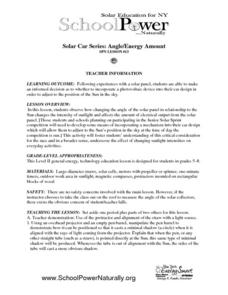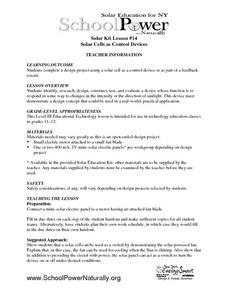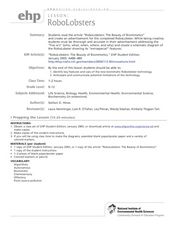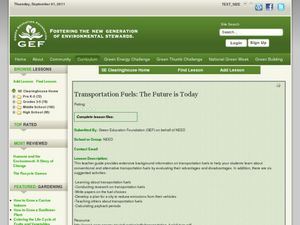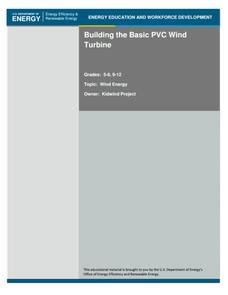Curated OER
Energy Resources: Where Are They and How Do We Get Them?
Future energy engineers visit several stations, each one dedicated to a different alternative source of energy. They describe how solar energy is converted into other forms of energy, the patterns of distribution of energy resources in...
Curated OER
Solar Car Series: Angle/Energy Amount
Does the angle of a solar panel change the output? Emerging engineers find out! Demonstrate for your class how they can angle a straw to match the angle of light rays coming from a source. Then turn them loose to experiment with the...
Curated OER
Solar Kit Lesson #14 - Solar Cells as Control Devices
Given four suggested concepts, emerging electrical engineers research, design, and constuct a working device that willrespond to changes in the intesnisty or the direction of sunlight. This is a challenge for learners to rise to, as the...
Curated OER
Baseball Math
In this math worksheet, students solve a variety of word problems pertaining to baseball and its statistics. Students answer 20 word problems, some of which require an Internet search to find certain players' statistics.
Houghton Mifflin Harcourt
Leveled Problem Solving: Angles
This splendid assignment gets future engineers to compute complementary or supplementary angles in real-life applications! Once they have mastered the art of additive angles, they can apply their knowledge to help Steve, Inez, Carlotta,...
Curated OER
Robo-Lobster
Introduce environmental science or engineering explorers to different forms of sampling. They read an article about "Robo-lobsters," lobsters being studied to help design robots that can used to sniff out pollution in ocean waters. The...
Curated OER
Particles: Size Makes All the Difference
High schoolers plot particle sizes of common airborne materials on a log scale. They read an article on particle size and its relationship to the ability to pass through the lungs, into the bloodstream, and eventually into the cells of...
Curated OER
Mission Possible: Energy Trade-offs
Teams of electrical engineers work together to develop plans for increasing electricity to a fictitious, but growing community. They consider different sources of electricity, both renewable and nonrenewable, the cost of building and...
Curated OER
Marine Energy
In small groups, energy engineers research and make a topographic map of a marine natural resource. They report to the rest of the class pros and cons of extracting their assigned resource. The two activities may take up to four class...
Curated OER
Transportation Fuels: The Future is Today
Assign each group of 3-4 upper elementary engineers to a different type of transportation fuel. A background information page is provided to get them started with researching their assigned fuel. Each group then produces an exhibit or a...
Curated OER
The Physics of Flight
Three activities allow young flight engineers to understand the 4 principles of flight (weight, lift, thrust, and drag), to construct a glider, and to create a propeller. Multicultural history and literature are integrated by reading...
Curated OER
Thomas Edison's Bright Ideas
Thomas Alva Edison may be one of the most well-known scientists to elementary or middle schoolers. Use his story to show that he invented more than just the light bulb and to inspire youngsters to work hard! You could use this on the...
Curated OER
Unit II: Worksheet 3 - Velocity
Future engineers analyze the motion of Robin, the roller skater, as he moves along a sidewalk. They graph the position versus time for three different occurrences. Questions are asked about the resulting graphs, reinforcing the concepts...
Curated OER
Unit VIII: Worksheet 3 - Central Force
Beginning physicists imagine being aerospace engineers by solving seven centripetal force problems. They calculate the work, speed, time, and acceleration of objects in orbit: a satellite around Earth, and Earth around the sun. This is a...
Curated OER
Circuit Math
Seven circuits are spread over three pages. One is a parallel circuit, one is a series circuit, and the rest are combinations. Emergent electrical engineers solve for current, voltage, or resistance. They fill in a chart for each...
Curated OER
Alloys
Tidy slides and lecture notes for each are included in this presentation on alloys. Instruction begins with the molecular arrangement of a pure element, gold, and progresses to a few example alloys: brass, steel, and nitinol. This...
Curated OER
Lesson: Hovercraft Racers
Now, this lesson would be a blast! When your engineering or physics class is examining the reduction of friction or fluid dynamics, you can have them make these hovercraft racers. Using a balloon, a bottle cap, and a compact disc, middle...
Curated OER
How Does Your Garden Grow? Discovering How Weather Patterns Affect Natural Cycles
For the warm-up in this cool climate lesson, you will need to click on "Mapping" and then "US Mapping" once you arrive at NOAA's "US Climate at a Glance" page. Earth science explorers realize that 2012 was a warm winter for us. They read...
Curated OER
Comprensión de Lectura: Los Castores, los ingenieros de la naturaleza
Read about beavers, the engineers of nature! There's a page long reading passage, a set of comprehension questions, and seven vocabulary words to define. To ensure that your learners are carefully reading the text, have them highlight...
Google
Advanced 4: Searching for Evidence for Research Tasks
Research was very different in the past. Pupils once had difficulty finding sufficient information, but now they have the opposite problem. Show your class how to pick the best resources out of the millions of sites an online search will...
Polar Trec
What Is My Footprint?
How do one's habits and lifestyle choices affect the environment? Through a short online survey, learners will calculate their own carbon footprints then determine how to reduce their impact on the environment through simple steps, such...
Google
Intermediate 4: Searching for Evidence for Research Tasks
Online resources take many forms: blogs, search engines, news websites, documents, wikis. In order to conduct effective research, pupils should become familiar with different formats so that they can more easily choose suitable sites for...
National Research Center for Career and Technical Education
Architecture and Construction: Stair Construction
Within the context of the construction industry, algebra pros begin to calculate slope from the sizes of stair steps. This is a terrific lesson, especially for aspiring engineers. Just be aware that it might be a stretch to meet all of...
US Department of Energy
Building the Basic PVC Wind Turbine
Here is a comprehensive and well-written lesson plan that results in learners building a standard wind turbine. Once built, teens can design a variety of experiments to test different factors. This activity is a noble undertaking that...
Other popular searches
- Chemical Engineers
- Electrical Engineers
- Army Corp of Engineers
- Geotechnical Engineers
- Engineers and Communication
- Structural Engineers
- Sports Engineers
- Technical Engineers
- Army Corps of Engineers
- Engineers Edge
- Engineers and the Environment
- Environmental Engineers



